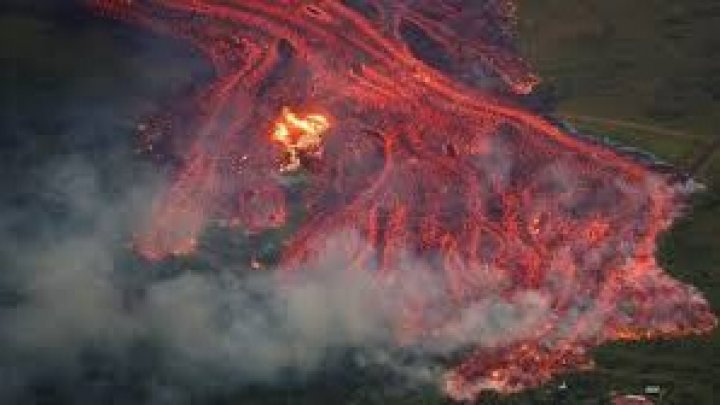Hawaii volcano: Man suffers serious leg injury as lava bomb threatens escape routes
 foto: This fast-moving flow in the Pahoe area consumed a home, seen here burning in the top left/EPA
foto: This fast-moving flow in the Pahoe area consumed a home, seen here burning in the top left/EPA
A stream of lava threatened to block a key Hawaii highway on Sunday that serves as an escape route for coastal residents, while the first known serious injury was reported from fresh explosive eruptions from the Kilauea volcano, writes Reuters.
A homeowner on Noni Farms Road who was on a third-floor balcony had his leg shattered from his shin to his foot when hit by lava spatter, said Janet Snyder, a spokesperson for the Office of the Mayor, County of Hawaii.
She added that lava spatters “can weigh as much as a refrigerator and even small pieces of spatter can kill.” No other information was immediately available.
As magma destroyed four more homes, molten rock from two huge cracks merged into a single stream, threatening to block escape routes and touching off brush fires.
The erupting lava, which can reach a blistering 2,000 degrees Fahrenheit (1,093 degrees Celsius), was expected to hit Highway 137 overnight if it kept up its rate and direction of flow, the County of Hawaii’s Civil Defense Agency said.
Authorities are trying to open up a road that was blocked by lava in 2014 to serve as an alternative escape route should Highway 137 or another exit route, Highway 130, be blocked, Jessica Ferracane of the National Park Service told reporters.
The park service is working to bulldoze almost a mile of hardened lava out of the way on nearby Highway 11, which has been impassable, she added.
The Hawaii National Guard has warned of mandatory evacuations if more roads become blocked.
But officials went house-to-house in the area to urge more residents to flee, Snyder said, though no head count of the new evacuation was available early Sunday.
They also warned of laze, clouds of hydrochloric acid and steam embedded with fine glass particles formed when hot lava hits ocean water.
For weeks, geologists have warned that hotter, fresher magma from Kilauea’s summit would run underground and emerge some 25 miles east in the lower Puna district, where older, cooler lava has already destroyed 44 homes and other structures.
“Summit magma has arrived,” U.S. Geological Survey scientist Wendy Stovall said on a conference call with reporters.
“There is much more stuff coming out of the ground and its going to produce flows that will move much further away.”
Fountains of bright orange lava were seen spouting at least 20-feet high, and spewing rivers of molten rock on Saturday.
Carolyn Pearcheta, operational geologist at the Hawaii Volcano Authority, told reporters that hotter and more viscous lava could be on the way, with fountains spurting as high as 600 feet, as seen in a 1955 eruption.
“We’ve seen the clearing out of the system,” she said. “We call that the ‘throat clearing’ phase.”
<iframe width="560" height="315" src="https://www.youtube.com/embed/iQCP3QvWHFw" frameborder="0" allow="autoplay; encrypted-media" allowfullscreen></iframe>

